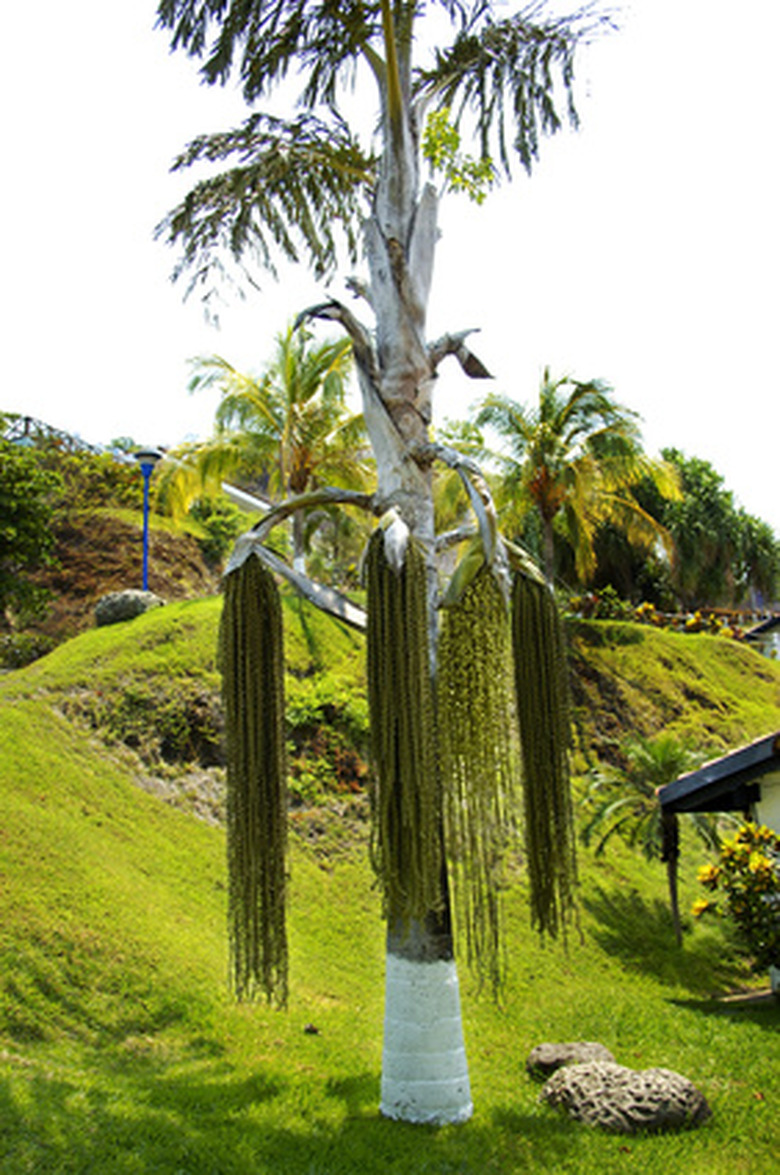How Palm Trees Grow Taller & Thinner With More Water
Palm trees are common parts of urban and coastal landscapes in tropical to sub-tropical regions. The plants vary in their water needs according to species. Most are fairly drought-tolerant once established but do require supplemental watering when young. Palm trees respond to over-watering and under-watering in different ways. Perfect water needs are difficult to pinpoint due to species, site and environmental differences. The palm that receives the correct amount of water will show the best growth.
Water Use in a Tree
Water is used by trees as a nutrient transporting solution and a hydrating solution for cells. Water is lost from the leaves in a process called evapotranspiration. It is important to keep the ambient air humid and to help force the transipiration process of moving nutrients. Evapotranspiration keeps the liquid pressure even as the tree uptakes more moisture. The process of evaportranspiration is cyclical and restores the balance of moisture to the air, which will then return to the soil.
- Palm trees are common parts of urban and coastal landscapes in tropical to sub-tropical regions.
- It is important to keep the ambient air humid and to help force the transipiration process of moving nutrients.
Taller Palm trees
The growth of a palm tree or any other plant is driven by the amount of nutrients it gets. It is the same with any organism. The nutrients the tree derives from soil fuel the cell development and growth. Because nutrients travel up the trunk, out the stems and to the leaves in a vascular system in a liquid, water is important to nutrient distribution. When the palm has good water intake, nutrients are able to get to even the tallest parts of the tree. This encourages good cell development and the lengthening of the vegetative parts of the palm. Taller growth is to be expected when the tree has sufficient water. Nitrogen contents of soil also fuel increased vegetative growth and taller palms. It can also make them initially thin until maturity and time have allowed them to fill out.
- The growth of a palm tree or any other plant is driven by the amount of nutrients it gets.
- The nutrients the tree derives from soil fuel the cell development and growth.
Thinner Palm Trees
Thinner palms are usually caused by growth in shade. The trees stretch for light and become spindly and thin. The same thing happens on other types of plants where the stems become unstable and spindly. Another cause of thin trunk development is improper nutrients. Since water is the driving force to transport food to the cells of the tree, lack of water will cause a dearth of fuel for development. This can cause stunting or thin trunks because cell formation is limited.
Palm Tree Roots
Palm tree root systems are fibrous and relatively shallow. The majority of the roots are small and formed at the base of the trunk in an area called the root initiation zone. These roots don't increase in diameter like other trees. The amount of nutrients the plant can access are generally close to the surface of the soil and near the trunk region. If soils are poor or supplemental fertilizer is not provided, the palm tree will not have good consistent growth, which can result in a malformed trunk that is not sturdy. Water intake draws up the nutrients, and palm tree root systems are limited in how fast they can harvest water. This is why a bubbler or drip system is useful on palms. It delivers water slowly enough that the plant has adequate time to intake the liquid before it runs off or evaporates.
- Thinner palms are usually caused by growth in shade.
- Water intake draws up the nutrients, and palm tree root systems are limited in how fast they can harvest water.
Amount of Water for Palms
Palm tree needs will vary but as a general rule they require the same amount of water as the pot they came in. A more general rule is to provide 1 inch of water every week. Newly planted palms need water daily until they build a root system. There after, most palms only need watering in summer. Mulching around the root zone is an effective way of conserving moisture in the soil. The soil should feel moist if you dig down 6 to 8 inches but should never be soggy. If the soil is cool 6 inches down, the plant is properly hydrated.
- Palm tree needs will vary but as a general rule they require the same amount of water as the pot they came in.
